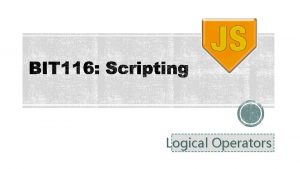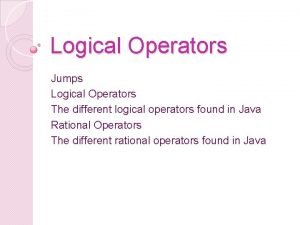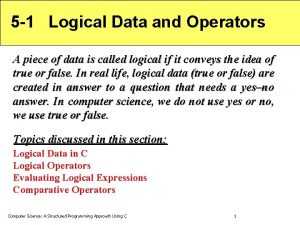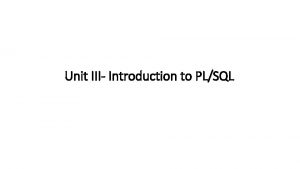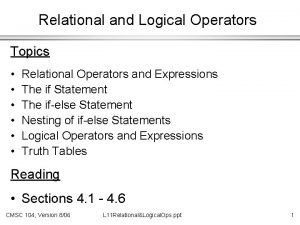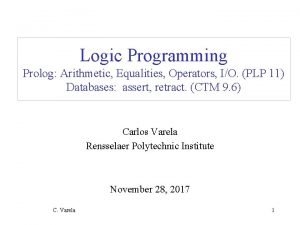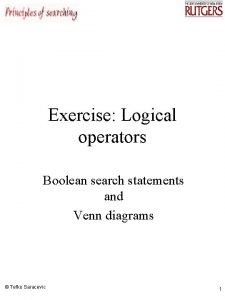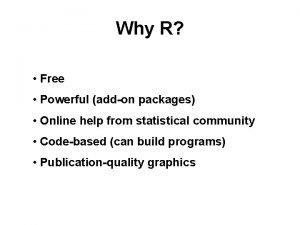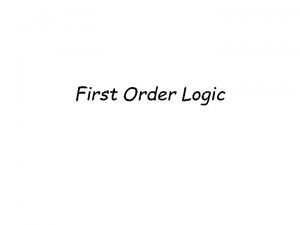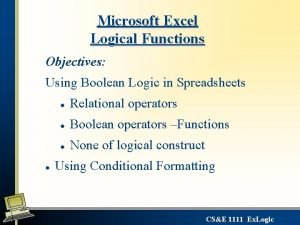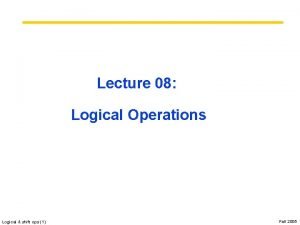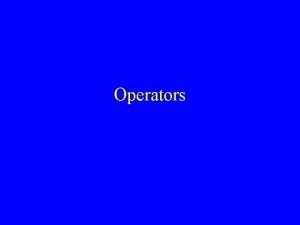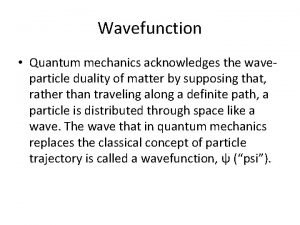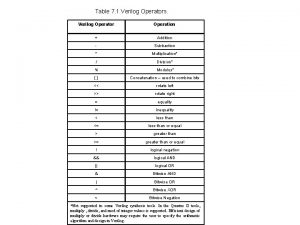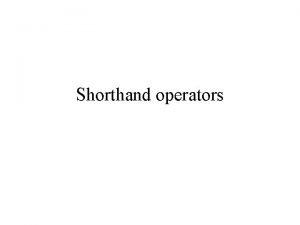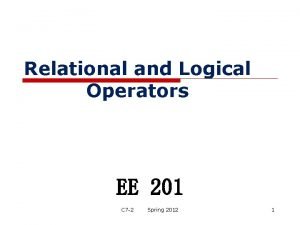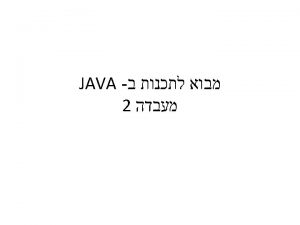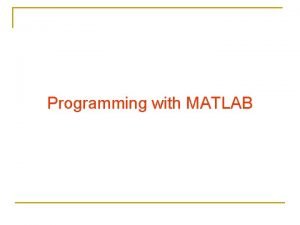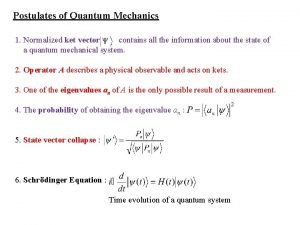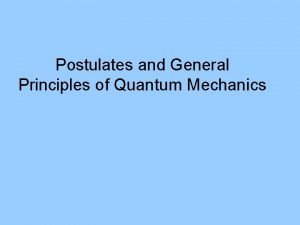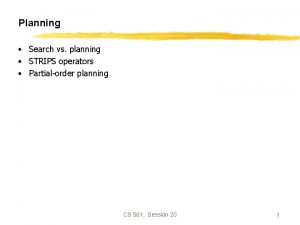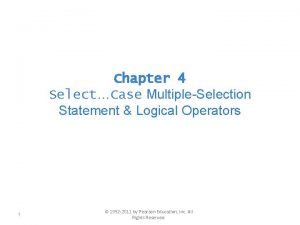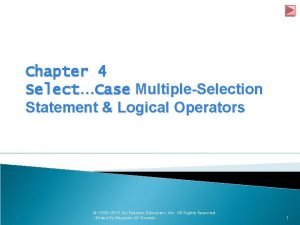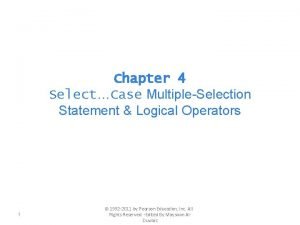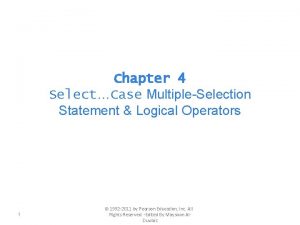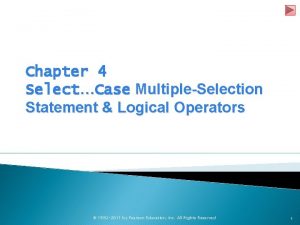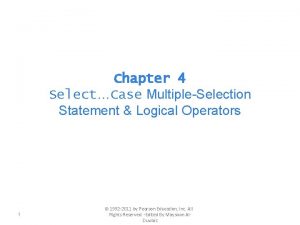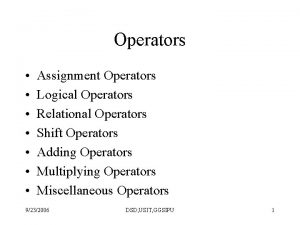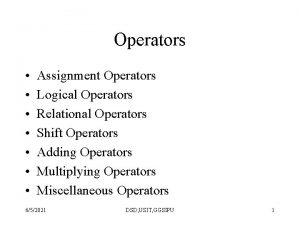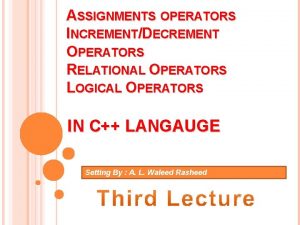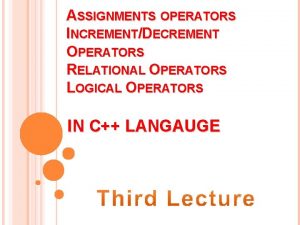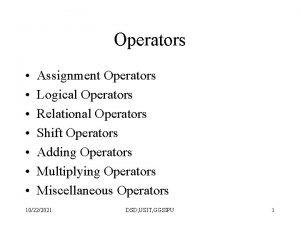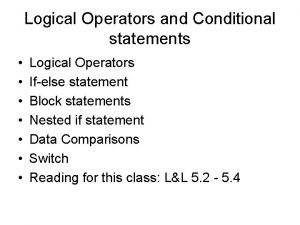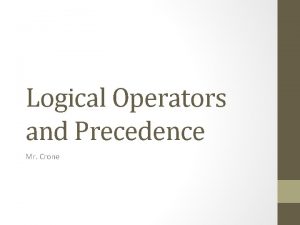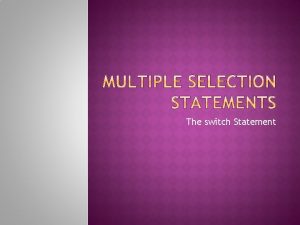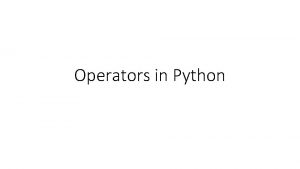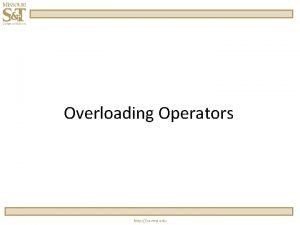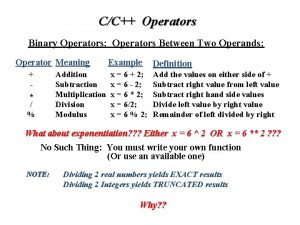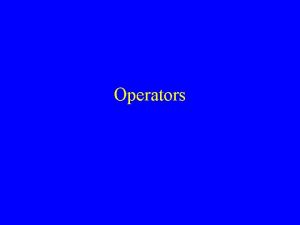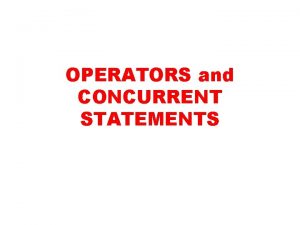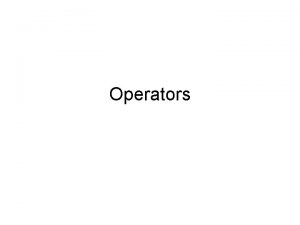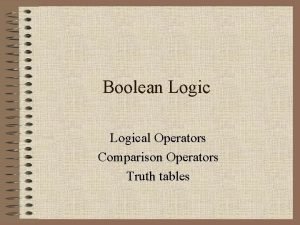Chapter 4 SelectCase MultipleSelection Statement Logical Operators 1































- Slides: 31

Chapter 4 Select…Case Multiple-Selection Statement & Logical Operators 1 © 1992 -2011 by Pearson Education, Inc. All Rights Reserved.

Select…Case Multiple-Selection Statement • If an algorithm takes different actions based on series of decisions to test variable values, Select…Case multiple • In slide#3, Select…Case statement is used to determine whether each grade is the equivalent of an A, B, C, D or F. • selection statement can be used. Select Case controlling expression Case. Label 1 Action 1 Case. Label 2 Action 2 Case Else. Action End Select • The output of the program is displayed in slide#5. 2 © 1992 -2011 by Pearson Education, Inc. All Rights Reserved.

The above program Use the Select Case Statement to determine the grade 3 © 1992 -2011 by Pearson Education, Inc. All Rights Reserved.

The above program Use If Then Else. If Statement to determine the grade - This program is equivalent to the one in previous slide#3 that uses Select Case 4 © 1992 -2011 by Pearson Education, Inc. All Rights Reserved.

When The user enters grade 77 and press the Calculate Score button of the Select Case Statement (The code in Slide#3) When The user Press one of the Calculate Score Button Without Entering any score in the Text. Box 5 When The user enters grade 77 and press the Calculate Score button of the If Then Else Statement (The code in Slide#4) When The user enters grade 89 and press one of the Calculate Score button © 1992 -2011 by Pearson Education, Inc. All Rights Reserved.

Select…Case Multiple-Selection Statement • A grade in the range: – – – 100 represents a Perfect A 90– 99 represents an A, 80– 89 represents a B, 70– 79 represents a C, 60– 69 represents a D and 0– 59 represents an F. • We assume that the user enters a grade in the range 0– 100. • The expression following the keywords Select Case (in this case, grade) is called the controlling expression. • It is compared in order with each Case. • If a matching Case is found, the code in the Case executes, then program control proceeds to the first statement after the Select…Case statement. 6 © 1992 -2011 by Pearson Education, Inc. All Rights Reserved.

Select…Case Multiple-Selection Statement • A Case statement can specify multiple actions: – Example: The Following Case has two actions: – The output will be as follows: • Keyword To specifies the range; – Example: Case 80 To 89 Means all the values [80, 81, 82, …. , 87, 88, 89] ranging between 80 to 89 7 © 1992 -2011 by Pearson Education, Inc. All Rights Reserved.

Select…Case Multiple-Selection Statement • If no match occurs between the controlling expression’s value (grade) and a Case label, the optional Case Else executes. • It is not necessary to write the Case Else. – Example: In Slide#3: If the User enters the value 59, the action of the Case Else will be executed as follows: 8 © 1992 -2011 by Pearson Education, Inc. All Rights Reserved.

Select…Case Multiple-Selection Statement • If no match occurs and the Select…Case does not contain a Case Else, program control simply continues with the first statement after the Select…Case. – Example: • If the code in slide#3 does not have the Case Else as bellow, when the user Enters the number 59 nothing will happen. Nothing is displayed 9 © 1992 -2011 by Pearson Education, Inc. All Rights Reserved.

Select…Case Multiple-Selection Statement • Case Else commonly is used to deal with invalid values. • In this example, we assume all values entered by the user are in the range 0– 100. • When used, the Case Else must be the last Case. • The required End Select keywords terminate the Select…Case statement. 10 © 1992 -2011 by Pearson Education, Inc. All Rights Reserved.

11 © 1992 -2011 by Pearson Education, Inc. All Rights Reserved.

Select…Case Multiple-Selection Statement • Types of Case Statements – Case statements also can use relational operators to determine whether the controlling expression satisfies a condition. • For example: Select Case grade Case Is < 0 Equivalent If grade < 0 Then uses keyword Is along with the relational operator, <, to test for values less than 0. 12 © 1992 -2011 by Pearson Education, Inc. All Rights Reserved.

Select…Case Multiple-Selection Statement • Types of Case Statements – Multiple values can be tested in a Case statement by separating the values with commas ( , ) as in – Case 0, 5 To 9 which tests for the value 0 or values in the range 5 – 9. – Also, Cases can be used to test String values 13 © 1992 -2011 by Pearson Education, Inc. All Rights Reserved.

Select…Case Multiple-Selection Statement • Select…Case Statement to test String values – Example: (The Select Color Example) A program that asks the user to enter one of the three basic colors (red, green, blue) if the input is correct the label change its color to the entered color. 14 © 1992 -2011 by Pearson Education, Inc. All Rights Reserved.

Select…Case Multiple-Selection Statement (The Select Color Example Program) 15 © 1992 -2011 by Pearson Education, Inc. All Rights Reserved.

Logical Operators • A condition is an expression that results in a Boolean value—True or False. • So far, we’ve studied only simple conditions, such as count <= 10, total > 1000 and number <> -1. • Each selection and repetition statement evaluated only one condition with one of the operators >, <, >=, <=, = and <>. 16 © 1992 -2011 by Pearson Education, Inc. All Rights Reserved.

Logical Operators • To handle multiple conditions more efficiently, the logical operators can be used to form complex conditions by combining simple ones. • Logical operators are And, Or, Xor and Not. 17 © 1992 -2011 by Pearson Education, Inc. All Rights Reserved.

Logical Operators • Logical And Operator – Suppose we wish to ensure that two conditions are both True in a program before a certain path of execution is chosen. – In such a case, we can use the logical And operator as follows: – If gender = "F" And age >= 65 Then senior. Females += 1 End If – This If…Then statement contains two simple conditions. 18 © 1992 -2011 by Pearson Education, Inc. All Rights Reserved.

Logical Operators • The condition gender = "F" determines whether a person is female and the condition age >= 65 determines whether a person is a senior citizen. • The two simple conditions are evaluated first, because the precedence of = and >= are both higher than the precedence of And. If gender = "F" And age >= 65 True If both are True then the condition of the If Statement is met 19 © 1992 -2011 by Pearson Education, Inc. All Rights Reserved.

Logical Operators • When this combined condition is True, the senior. Females count is incremented by 1. gender = "F" age >= 65 Is the If Condition met? True False True False • The readability of the preceding combined condition can be improved by adding parentheses: (gender = "F") And (age >= 65) 20 © 1992 -2011 by Pearson Education, Inc. All Rights Reserved.

Logical Operators • Logical Or Operator – Now let’s consider the Or operator. – Suppose we wish to ensure that either or both of two conditions are True before we choose a certain path of execution. – We use the Or operator as in the following program segment: If (semester. Average >= 90 Or final. Exam >= 90) Then result. Label. Text = "Student grade is A" End If – This statement also contains two simple conditions. 21 © 1992 -2011 by Pearson Education, Inc. All Rights Reserved.

Logical Operators • The condition semester. Average >= 90 is evaluated to determine whether the student deserves an “A” in the course because of his performance throughout the semester. • The condition final. Exam >= 90 is evaluated to determine whether the student deserves an “A” in the course because of his performance on the final exam. 22 © 1992 -2011 by Pearson Education, Inc. All Rights Reserved.

Logical Operators • The If…Then statement then considers the combined condition (semester. Average >= 90 Or final. Exam >= 90) and awards the student an “A” if either or both of the conditions are True. • The text "Student grade is A" is displayed, unless both of the conditions are False. • The And operator has a higher precedence than Or. 23 © 1992 -2011 by Pearson Education, Inc. All Rights Reserved.

24 © 1992 -2011 by Pearson Education, Inc. All Rights Reserved.

Logical Operators • Logical Xor Operator – A condition containing the logical exclusive OR (Xor) operator is True if and only if one of its operands results in a True value and the other results in a False value. – If both operands are True or both are False, the entire condition is False. 25 © 1992 -2011 by Pearson Education, Inc. All Rights Reserved.

Logical Operators • Logical Not Operator – The Not (logical negation) operator enables you to “reverse” the meaning of a condition. – Unlike the logical operators And, Or and Xor, which each combine two conditions, the logical negation operator is a unary operator, requiring only one operand. 26 © 1992 -2011 by Pearson Education, Inc. All Rights Reserved.

Logical Operators • The logical negation operator is demonstrated by the following program segment: If Not (value = 0) Then result. Label. Text = "The value is " & value End If • The parentheses around the condition value = 0 are necessary because the logical negation operator (Not) has a higher precedence than the equality operator. 27 © 1992 -2011 by Pearson Education, Inc. All Rights Reserved.

Logical Operators • In most cases, you can avoid using logical negation by expressing the condition differently with relational or equality operators. • This flexibility helps you express conditions more naturally. • For example, the preceding statement can be written as follows: Can be written as If Not (value = 0) Then 28 If value <> 0 Then © 1992 -2011 by Pearson Education, Inc. All Rights Reserved.

Operators’ Precedence 29 © 1992 -2011 by Pearson Education, Inc. All Rights Reserved.

Example #1 X += ( 4 y * 2 ) ^ ( x – 2 ) 1 2 3 4 5 30 © 1992 -2011 by Pearson Education, Inc. All Rights Reserved.

Example #2 If Not( x * y < 0 ) And ( x ^ 2 >= 100 Mod 4 ) 1 3 2 4 5 6 7 31 © 1992 -2011 by Pearson Education, Inc. All Rights Reserved.
 Matlab bilkent
Matlab bilkent What is truth table in boolean algebra
What is truth table in boolean algebra Logical operators quiz
Logical operators quiz Rational vs logical
Rational vs logical Logical operators calculator
Logical operators calculator Pl sql operators
Pl sql operators Operator precedence
Operator precedence Prolog operators
Prolog operators Boolean venn diagram
Boolean venn diagram Logical operators priority in c
Logical operators priority in c And or operator
And or operator Exclusive or logical equivalence
Exclusive or logical equivalence Google search logical operators
Google search logical operators Logical operators in r
Logical operators in r Logical operators in r
Logical operators in r Compound proposition truth table
Compound proposition truth table Excel boolean logic
Excel boolean logic Logical shift
Logical shift Perl bitwise operators
Perl bitwise operators Logical form and logical equivalence
Logical form and logical equivalence Borns interpretation of wave function
Borns interpretation of wave function Vbscript modulus
Vbscript modulus Verilog operator
Verilog operator Shorthand operator in java
Shorthand operator in java Relational operators
Relational operators Postulates of quantum mechanics
Postulates of quantum mechanics Class operators public static void main
Class operators public static void main Relational operators matlab
Relational operators matlab Site:slidetodoc.com
Site:slidetodoc.com Operators in quantum mechanics
Operators in quantum mechanics Pl sql meaning
Pl sql meaning Strips operators
Strips operators


